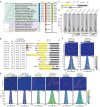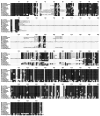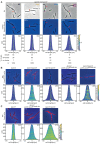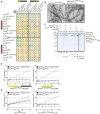PomX, a ParA/MinD ATPase activating protein, is a triple regulator of cell division in Myxococcus xanthus
- PMID: 33734087
- PMCID: PMC7993993
- DOI: 10.7554/eLife.66160
PomX, a ParA/MinD ATPase activating protein, is a triple regulator of cell division in Myxococcus xanthus
Abstract
Cell division site positioning is precisely regulated but the underlying mechanisms are incompletely understood. In the social bacterium Myxococcus xanthus, the ~15 MDa tripartite PomX/Y/Z complex associates with and translocates across the nucleoid in a PomZ ATPase-dependent manner to directly position and stimulate formation of the cytokinetic FtsZ-ring at midcell, and then undergoes fission during division. Here, we demonstrate that PomX consists of two functionally distinct domains and has three functions. The N-terminal domain stimulates ATPase activity of the ParA/MinD ATPase PomZ. The C-terminal domain interacts with PomY and forms polymers, which serve as a scaffold for PomX/Y/Z complex formation. Moreover, the PomX/PomZ interaction is important for fission of the PomX/Y/Z complex. These observations together with previous work support that the architecturally diverse ATPase activating proteins of ParA/MinD ATPases are highly modular and use the same mechanism to activate their cognate ATPase via a short positively charged N-terminal extension.
Keywords: FtsZ; MinD; MinE; ParA; ParB; bacterial cell division; cell biology; infectious disease; microbiology.
© 2021, Schumacher et al.
Conflict of interest statement
DS, AH, SB, EF, LS No competing interests declared
Figures












Similar articles
-
Biomolecular condensate drives polymerization and bundling of the bacterial tubulin FtsZ to regulate cell division.Nat Commun. 2023 Jun 28;14(1):3825. doi: 10.1038/s41467-023-39513-2. Nat Commun. 2023. PMID: 37380708 Free PMC article.
-
The PomXYZ Proteins Self-Organize on the Bacterial Nucleoid to Stimulate Cell Division.Dev Cell. 2017 May 8;41(3):299-314.e13. doi: 10.1016/j.devcel.2017.04.011. Dev Cell. 2017. PMID: 28486132
-
PomZ, a ParA-like protein, regulates Z-ring formation and cell division in Myxococcus xanthus.Mol Microbiol. 2013 Jan;87(2):235-53. doi: 10.1111/mmi.12094. Epub 2012 Dec 19. Mol Microbiol. 2013. PMID: 23145985
-
Regulation of Cell Polarity in Motility and Cell Division in Myxococcus xanthus.Annu Rev Microbiol. 2017 Sep 8;71:61-78. doi: 10.1146/annurev-micro-102215-095415. Epub 2017 May 19. Annu Rev Microbiol. 2017. PMID: 28525300 Review.
-
Bacterial Nucleoid Occlusion: Multiple Mechanisms for Preventing Chromosome Bisection During Cell Division.Subcell Biochem. 2017;84:267-298. doi: 10.1007/978-3-319-53047-5_9. Subcell Biochem. 2017. PMID: 28500529 Review.
Cited by
-
Milestones in the development of Myxococcus xanthus as a model multicellular bacterium.J Bacteriol. 2025 Jul 24;207(7):e0007125. doi: 10.1128/jb.00071-25. Epub 2025 Jun 17. J Bacteriol. 2025. PMID: 40525847 Free PMC article. Review.
-
Dissecting the phase separation and oligomerization activities of the carboxysome positioning protein McdB.Elife. 2023 Sep 5;12:e81362. doi: 10.7554/eLife.81362. Elife. 2023. PMID: 37668016 Free PMC article.
-
Tuning the interaction of a ParA-type ATPase with its partner separates bacterial organelle positioning from partitioning.Res Sq [Preprint]. 2025 Jun 17:rs.3.rs-6728214. doi: 10.21203/rs.3.rs-6728214/v1. Res Sq. 2025. PMID: 40585260 Free PMC article. Preprint.
-
Biomolecular condensate drives polymerization and bundling of the bacterial tubulin FtsZ to regulate cell division.Nat Commun. 2023 Jun 28;14(1):3825. doi: 10.1038/s41467-023-39513-2. Nat Commun. 2023. PMID: 37380708 Free PMC article.
-
An invariant C-terminal tryptophan in McdB mediates its interaction and positioning function with carboxysomes.Mol Biol Cell. 2024 Aug 1;35(8):ar107. doi: 10.1091/mbc.E23-11-0443. Epub 2024 Jun 26. Mol Biol Cell. 2024. PMID: 38922842 Free PMC article.
References
Publication types
MeSH terms
Substances
Grants and funding
LinkOut - more resources
Full Text Sources
Other Literature Sources

